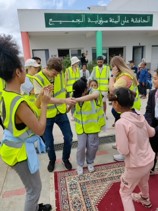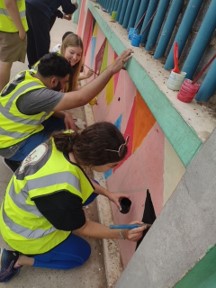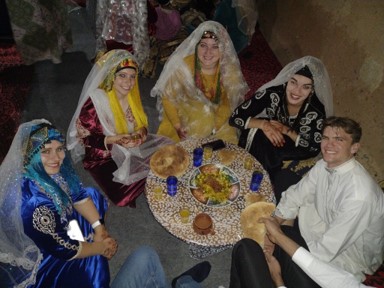Immersion in Morocco

Recently, I had the opportunity to hear from Aletha Stahl, a senior intercultural learning specialist at Purdue University's CILMAR (Center for Intercultural Learning, Mentorship, Assessment and Research), as she tells me how she used HubICL resources to enrich her study abroad program. Following are some highlights from our Q&A.
Introduction
Aletha Stahl recently returned from co-leading a 3-week program in Morocco. The course, offered through the Department of Human Development and Family Studies at Purdue University, explored youth in  development – what the present and future look like to young people in Morocco in vastly different social and geographic contexts. Specific learning outcomes focused on comparing sociocultural factors and values influencing Moroccan family life and US family life, applying culturally-relevant knowledge and intercultural teamwork skills, sharpening emotional resilience, and identifying how worldview impacts perceptions, behaviors, and communication.
development – what the present and future look like to young people in Morocco in vastly different social and geographic contexts. Specific learning outcomes focused on comparing sociocultural factors and values influencing Moroccan family life and US family life, applying culturally-relevant knowledge and intercultural teamwork skills, sharpening emotional resilience, and identifying how worldview impacts perceptions, behaviors, and communication.
What was the design of your program?
With o ur partner/provider Morocco Exchange, my co-leader Dr. Natasha Watkins and I designed an itinerary with the goal of balancing deep cultural immersion (i.e., two homestays, projects developed with Moroccan peers, partnering with the Moroccan peers on a community engagement activity) and small doses of more surface cultural tourism with RRR (rest & relaxation & reflection) periods in quiet rural settings. The program design was a first for all of us, and although our program was not organized primarily around community engagement, a tool that stimulated our thinking about it is the Fair Trade Learning Rubric.
ur partner/provider Morocco Exchange, my co-leader Dr. Natasha Watkins and I designed an itinerary with the goal of balancing deep cultural immersion (i.e., two homestays, projects developed with Moroccan peers, partnering with the Moroccan peers on a community engagement activity) and small doses of more surface cultural tourism with RRR (rest & relaxation & reflection) periods in quiet rural settings. The program design was a first for all of us, and although our program was not organized primarily around community engagement, a tool that stimulated our thinking about it is the Fair Trade Learning Rubric.
Ah, the Fair Trade Learning Rubric is published in the Intercultural Learning Hub (HubICL). Were you able to use other materials that are in the HubICL?
Resources available in the Hub played an important role before, during, and after the program. As pre-departure activities we used Voices from the Past, Social Identity Wheel, and Pacing. After observing challenges that arose within the broader Purdue and Moroccan peer group once we got to Morocco, we determined that facilitating Pacing or another communication activity with all the students could lay the groundwork for helpful meta-communication and more empathy in future programs.
In Morocco, the broader group viewed Danger of a Single Story together, and it clearly left a mark as several students brought it up in later discussions. In response to Purdue student journal reflections, we brought in the Intensity Factors Index during our first RRR period with the purpose of helping students both name stressors and identify and share strategies they were already using to manage these. You can see how we used it in a review I wrote for the tool. We also facilitated A Flower’s Point of View just before entering the second homestay so as to focus on the complexity of empathy and discuss the Platinum Rule (“Do unto others as they would have us do unto them”), which we wanted students to consider applying both with their host families and with each other as responses to intercultural challenges are often very different.
How did you assess the students’ intercultural growth?
For assessments, we used the Intercultural Effectiveness Scale (IES) as a formative pre-departure tool and had students complete it soon after their return and comment on their scores. In response to a low World Orientation score, one student wrote, “While I am confident in my open mind and my desire to learn more about other cultures through travel, there are things I can be doing now to learn more about the world around me.” Another noted, “I was pleased to see that my relationship development was standing at a 6.0 and my exploration was at 4.0. This reflected back upon the relationships I developed in Morocco and the desire I have to continue traveling and learning about the world.” The group moved an average of two points (on a seven-point scale) in this indirect measure of intercultural development.
used the Intercultural Effectiveness Scale (IES) as a formative pre-departure tool and had students complete it soon after their return and comment on their scores. In response to a low World Orientation score, one student wrote, “While I am confident in my open mind and my desire to learn more about other cultures through travel, there are things I can be doing now to learn more about the world around me.” Another noted, “I was pleased to see that my relationship development was standing at a 6.0 and my exploration was at 4.0. This reflected back upon the relationships I developed in Morocco and the desire I have to continue traveling and learning about the world.” The group moved an average of two points (on a seven-point scale) in this indirect measure of intercultural development.
We also administered the Scale of Ethno-cultural Empathy as a retrospective-pre/post assessment that students completed shortly after returning. Again, the changes were significant on almost all the empathy subscales.
Not least, we asked students to produce critical reflections during and after the program based on prompts that aligned with categories on the IES or related to the topic of the course. These were submitted in a combination of written journal entries and social media posts (student choice of platform). Key themes that emerged from these reflections include self-discovery and perspective taking. In response to host family stays, one student wrote, “I personally am a person who can’t wait to live on my own and live my own life, but I’ve gotten to uncover a new part of myself that also craves so much togetherness with my close family.” Another student offered this Instagram post: “On this trip I’ve spent a number of hours looking up at the stars. These three pictures show just a few angles and locations of the night sky. I chose these images because the stars are interpreted by people differently. Depending on the way you’re angled, your previous knowledge, and imagination you can see a variety of different things in the sky. . . This can be used as we interpret the experiences on this trip, taking note of our own background and those of others we interacted with.”
How did the students face language challenges?
Because host families in the first homestay spoke Darija (Moroccan Arabic) and in the second, Tashelhit (an indigenous Amazigh language), students learned basic words in both but were pushed to grow their non-verbal communication skills. As one reflected at the end, “When living in the villages, I viewed communication as forming a connection rather than understanding a language. It was more meaningful for me to understand the context of a joke and laugh together with my host family than focus on the idea of language.”
When leading a study abroad, it would seem that leaders can learn as much or more than the students do. What did you learn about yourself through this experience?
Beyond student growth, the learning abounded for me. I had already led nine immersion programs ranging from 2 weeks to full semesters and encountered the familiar challenge of juggling opportunities for my own immersive learning with stepping back to help manage the student experience and to evaluate it with a view toward future improvements. My co-leader and I also discussed the extent to which we often “sat on our hands” to ensure that students went through, processed, and framed their own experiences even as we recognized the importance of helping shape them or adding complexity at times.
Toward the end of the program, I  faced the ugly fact that when stressed and in an urgent situation, I readily fall back on learned patterns of white saviorism that are harmful to others. The program essentially had four leaders – two from Purdue and two from Morocco Exchange. The student group was small in number, and Morocco Exchange handled most of the in-country logistics. While these factors were freeing at first, by the third week I experienced what I identify from the Intensity Factor Index as loss of power and control and loss of status, exacerbated by the fact that my participation was primarily to help launch a program that I would be unlikely to lead again. I continue exploring the source of those feelings and seeking new strategies for managing them so that I can better live into my ideals for partnership wherever I am.
faced the ugly fact that when stressed and in an urgent situation, I readily fall back on learned patterns of white saviorism that are harmful to others. The program essentially had four leaders – two from Purdue and two from Morocco Exchange. The student group was small in number, and Morocco Exchange handled most of the in-country logistics. While these factors were freeing at first, by the third week I experienced what I identify from the Intensity Factor Index as loss of power and control and loss of status, exacerbated by the fact that my participation was primarily to help launch a program that I would be unlikely to lead again. I continue exploring the source of those feelings and seeking new strategies for managing them so that I can better live into my ideals for partnership wherever I am.
Conclusion
While we called Purdue students’ attention to their travel privileges -- they all held US passports and could muster the resources for the trip – this fact was brought home in their interaction with their Moroccan peers. Privileged or not, as one co-leader put it, that “the gaze goes both ways,” and as another pointed out, we “bring the world” to people who want to but can’t travel.
Whatever the reciprocity of the experience, it as a gift to learn with and from hosts, students, and co-leaders in a cultural immersion context. The HubICL is a rich source of tools that can be used to prepare, deepen, and assess the learning for both learners and leaders.
Matilda Genao @ on
The choice of topics for a business essay can be extremely varied, since this field covers many aspects of the modern economy. You can consider business essay topics https://paperwriter.com/blog/business-essay-topics related to entrepreneurship, such as analyzing successful startups and the factors that contribute to their growth. The topic of innovation can also be interesting, as the study of new technologies and their impact on business models is becoming more and more relevant.
Reply Report abuse